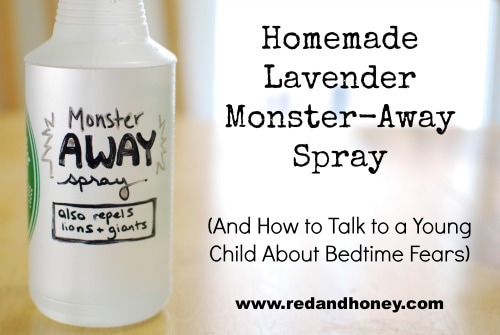
The day is drawing to a close. Dinnertime is finished, cute little tooshes have been scrubbed clean in the bath, story-time is over, and even One-More-Story-Pleeeease-time is done. Time to snuggle and get into cozy beds when all of a sudden you hear it: a low growl, or heavy breathing. Those darn monsters in the closet again!
For my four-year-old, it’s either monsters, lions, or giants. They come every night, and they’re usually hiding out in the dresser drawers. We dutifully shoe them away every time, but the pesky things just keep coming back.
It can be so difficult to know the best way to deal with these sorts of things as a parent. Do we play in to the imaginative aspect? Do we flat-out deny the possibility? Do we try to just brush it off as being ridiculous?
My husband and I have a range of inner reactions when dealing with these bedtime fears in our preschooler (and now the toddler, who is learning from her older brother!). It can be frustrating when he just won’t listen to “reason”, and it is heart-wrenching to know that your child is experiencing scary feelings that you cannot take away as easily as you used to. In these times, empathy and understanding are your best and most important tools.
It is so much easier to be compassionate when we have a clear understanding of the issue. While there are a few things that can exacerbate the problem (life events and transitions, scary images in his media intake), it is important to remember that nighttime fears are a perfectly normal part of a child’s development. In fact, they are indicative of a healthy cognitive understanding of the world.
Yes, it’s true that there are scary things in the world. It’s also true that mommy and daddy aren’t the all-powerful beings that he believed them to be in his toddlerhood. This is a normal part of growing in understanding as he gets older, but it can be unsettling for him. He is in previously uncharted territory, and is understandably nervous. He is also just learning to separate the real world from his imagination, which is why simply telling him that monsters do not exist is not an effective strategy.
Your job in all of this is to help him to feel safe and secure while also acknowledging and validating his emotional needs. Simple enough, right? Not always! Here are a few ideas of how to accomplish this.

1) Monster-Away Spray
Fill a spray bottle with water and add a few drops of lavender* essential oil (enough to make it smell mildly of lavender – around 5-10 drops). Use permanent marker to make a “label” (or design one on the computer, print it out, and tape it on if you’re the crafty type). Mine says “also repels lions and giants” at the bottom because those are my four-year-old’s current nighttime fears. Each night at bedtime when he says he’s scared use the spray. You can use it preventatively (“this spray will make the monsters scared to come around!”) or reactively (“this spray makes the monsters run away because they’re afraid of getting wet!”), depending on your child’s needs.
* Lavender essential oil has a natural soothing and calming effect.
2) Offer a Protector Role
Parents often try to use stuffed animals or dolls as comfort for their scared child, but sometimes it’s just not enough. A researcher at a Tel Aviv university who conducted a study on childhood fears recommends using what he calls a “Huggy Puppy”.
“…children are presented with a stuffed dog and told that the once happy puppy is now sad. They are given the responsibility of being the puppy’s friend, caring for him, and ensuring that he is not afraid at night. Because this intervention depends on the child’s willingness to believe the puppy’s story and embrace their new compassionate role, it works best for children with stronger imaginations…” (source)
3) Enter the Narrative
Don’t say “Oh my goodness, you’re right, these monsters are terrifying!” Instead, join the narrative in order to steer it in a different direction. “How about Daddy gathers up all of the monsters and throws them in the trash for the trash collector to take away? They’ll try and escape, but they can’t, because they’re all stuck together and dizzy from rolling around in the trash can, so they just look silly!” A little bit of silliness is helpful – the laughter will help release some of those tensions, and your child will feel empowered knowing that you understand “the situation” and have it under control.
4) Role-Playing
In Playful Parenting, Dr. Lawrence J. Cohen talks about play as one of the most basic and effective tools for great parenting. I am reading this book right now and absolutely love it. In one part, he says this when talking about play fighting:
“I like to play bad guys or monsters who are just a little bit scary, but also kind of funny, bumbling, and incompetent, so children can use play to overcome their fears. If the bad guys or monsters are too scary, the play just increases children’s fear.”
Find that fine balance between acknowledging the fear and allowing your child’s imagination to work out a solution (ie. they aren’t really that scary after all because they’re so funny, etc), and you’re well on your way.
5) Things to Avoid
Things that may make the problem worse include forcing a child to stay alone in his room alone when scared, punishing or bribing, or forcing your child to “face his fears” in a way that makes him uncomfortable. These things will likely just harm your connection to your child, and make him feel even more fearful because he now has to deal with the fear on his own. Things to avoid saying:
- You’re a big kid/don’t be a baby.
- There’s no need to be scared.
- There’s no such thing as monsters, don’t be ridiculous.
Further reading from around the web:
Original article and pictures take redandhoney.com site
Комментариев нет:
Отправить комментарий